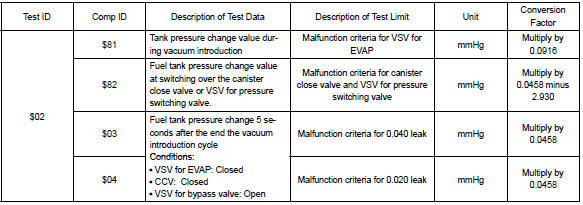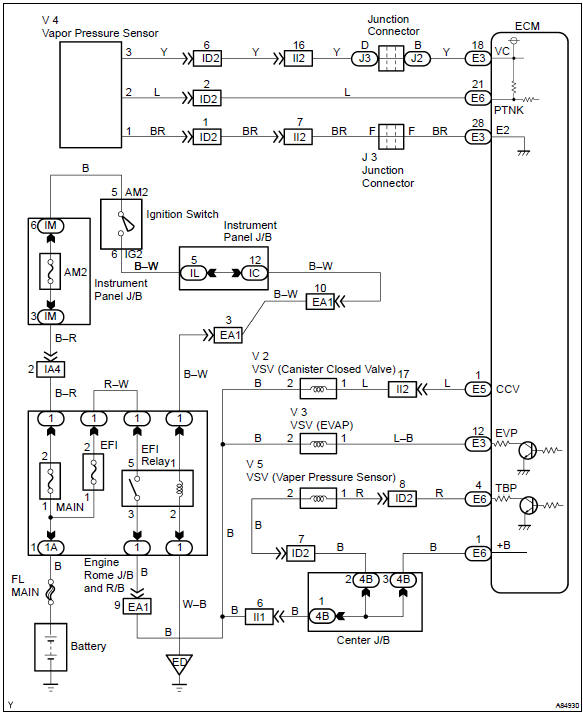Toyota Corolla (E120) 2002–2008 Repair Manual / Diagnostics / Sfi system / Evaporative emission control
system / Circuit description
Toyota Corolla (E120): Circuit description
The vapor pressure sensor, vsv for canister closed valve (ccv), vsv for pressure switching valve are used to detect abnormalities in the evaporative emission control system.
The ecm decides whether there is an abnormality in the evaporative emission control system based on the vapor pressure sensor signal.
Dtcs p0441 and p0446 are recorded by the ecm when evaporative emissions leak from the components within the dotted line in fig. 1 Below, or when there is malfunction in both vsv for evap and vsv for pressure switching valve, or in the vapor pressure sensor itself.


Hint
: typical dtc output of each trouble part.

*1: Ecm may output some other dtcs combination.
*2: Refer to p0442 and p0456.
Monitor description
P0441
The ecm checks for a stuck closed malfunction in the vsv for evap by commanding it to open with the ccv closed. If a high negative pressure does not develop inthe fuel tank, the ecm determines that the vsv for evap remains closed. The ecm turns on the mil and a dtc is set.
The ecm checks for vsv for evap ”stuck open” fault by commanding both valves (vsv for evap and ccv) to close at a time when the fuel tank is at atmospheric pressure. If the fuel tank develops a high negative pressure at this early stage of the test, the ecm determines that the vsv for evap is stuck open.
The ecm will turn on the mil and a dtc is set.
P0446
If there is a malfunction detected in the vsv for evaporative emission (evap), the canister closed valve (ccv) and the vsv for bypass valve; the ecm will illuminate the mil and set a dtc.
This portion of the evap diagnosis checks the following evap system functions:
- ccv stuck closed.
The ecm checks for a ccv ”stuck closed” malfunction by commanding the ccv to open after an evap leak test. If the fuel tank pressure does not rise (lose vacuum), the ecm determines that the ccv is stuck closed. The ecm will turn on the mil and a dtc is set.
- vsv for pressure switching valve stuck closed.
The ecm checks for a vsv for pressure switching valve ”stuck closed” malfunction by commanding the vsv for pressure switching valve to close after an evap leak test. If the fuel tank pressure does not change, the ecm determines that the vsv for pressure switching valve is malfunctioning. The ecm will turn on the mil and a dtc is set.
- vsv for evap (purge line to intake manifold) stuck closed.
The ecm checks for a stuck closed malfunction in the vsv for evap by commanding it to open with the ccv closed. If a high negative pressure does not develop inthe fuel tank, the ecm determines that the vsv for evap remains closed. The ecm turns on the mil and a dtc is set.
Monitor strategy

Typical enabling conditions

Typical malfunction thresholds
P0441

P0446

Monitor result (mode 06 data)

Refer for the detailed information on checking monitor status.
Wiring diagram

Other materials:
Headlight aim (vehicles
with front side
marker lights [bulb
type] )
Vertical movement adjusting
bolts
Adjustment bolt A
Adjustment bolt B
Before checking the headlight
aim
Make sure the vehicle has a
full tank of gasoline and the
area around the headlight is
not deformed.
Park the vehicle on level
ground.
Make sure the tire inflation
pressure is at the ...
Out side moulding
Replacement
Hint:
use the same procedures for the rh side and lh side.
1. Remove outside moulding
Put protective tape around the moulding.
insert a piano wire between the vehicle body and moulding.
tie objects that can serve as handles (for example, wooden
blocks) to all ...
On–vehicle inspection
1. Connect hand–held tester:
connect the hand–held tester to the dlc3.
start the engine and run it at idle.
select the active test mode on the hand–held tester.
Hint:
please refer to the hand–held tester operator’s manual for further details.
2. Inspect actua ...


